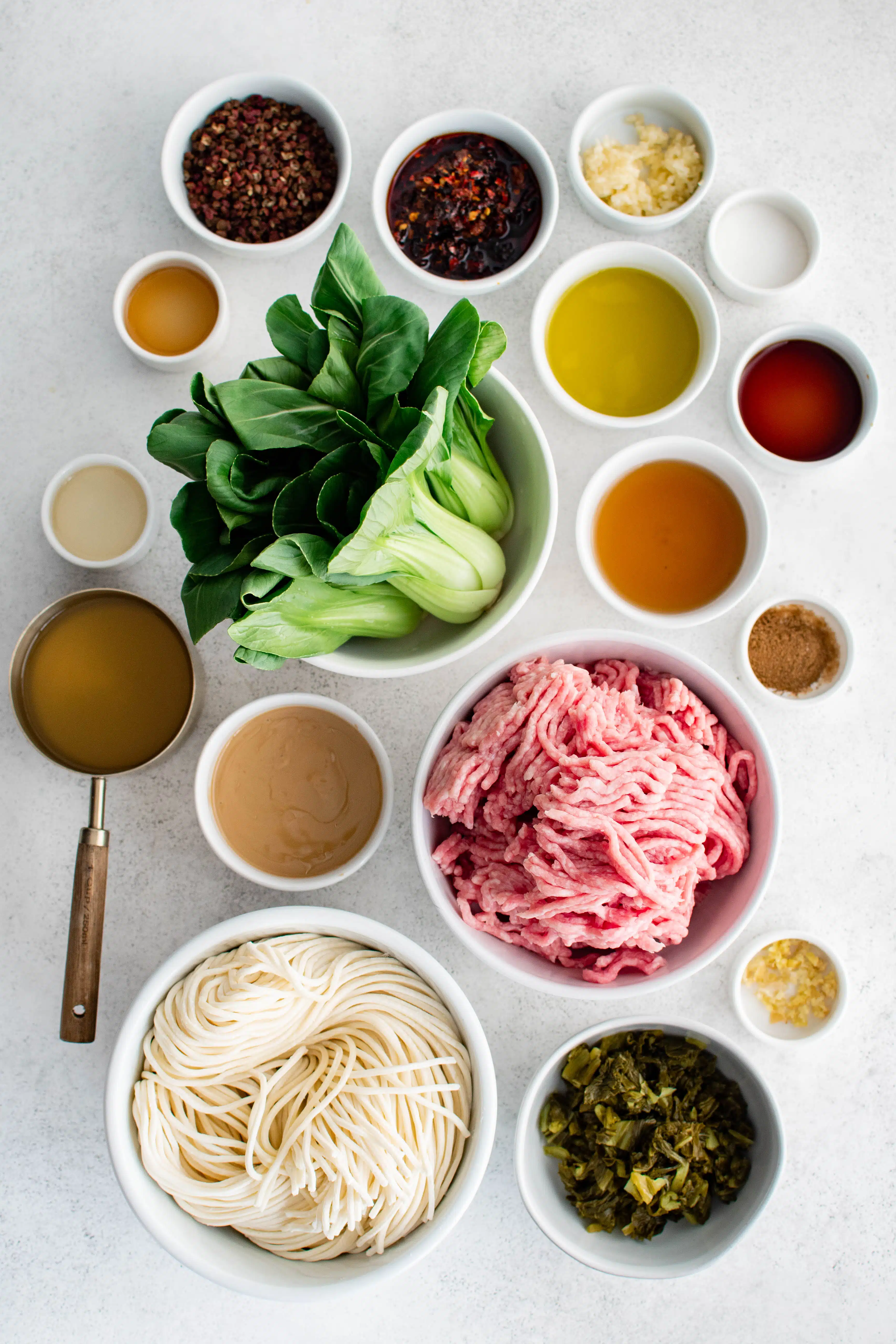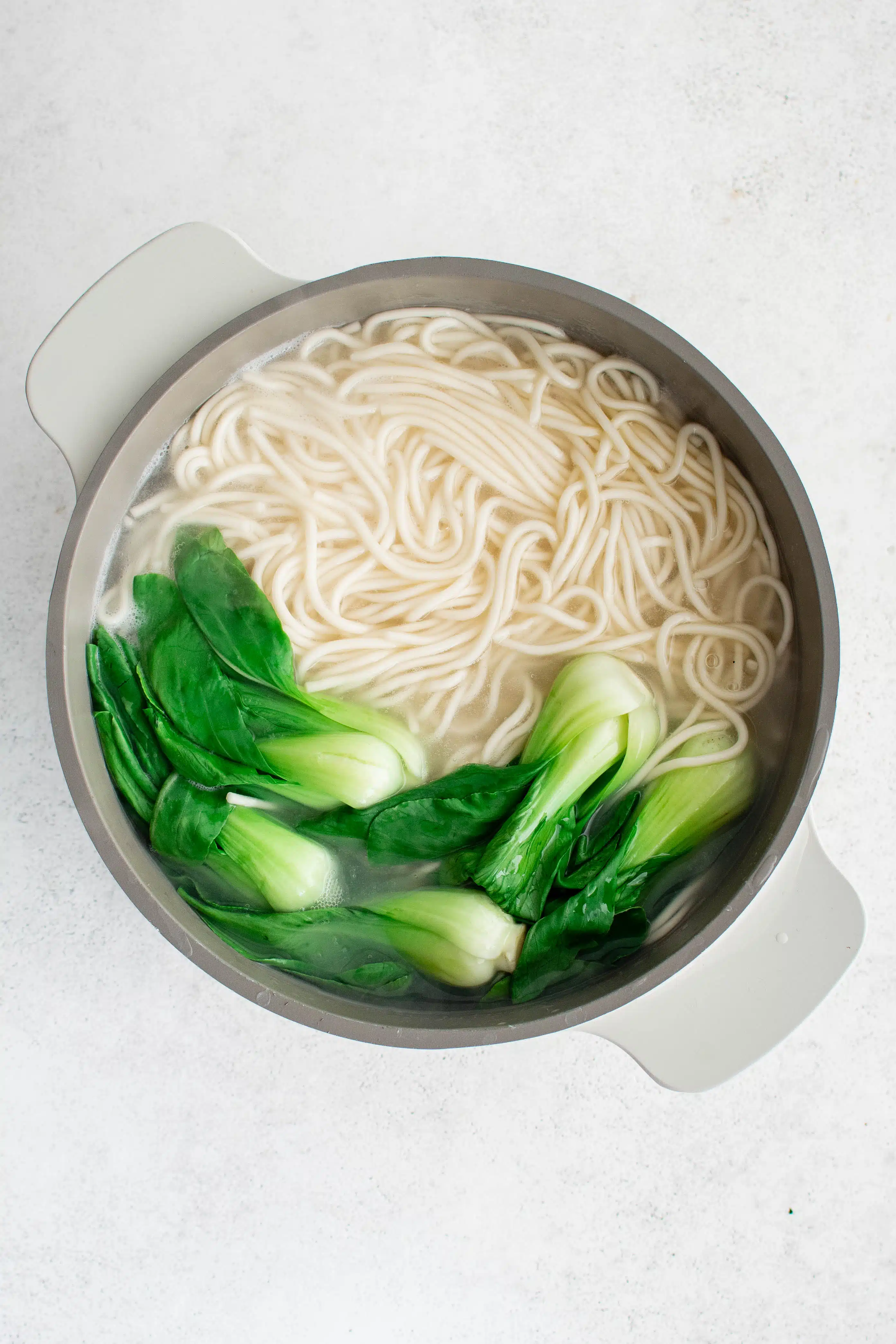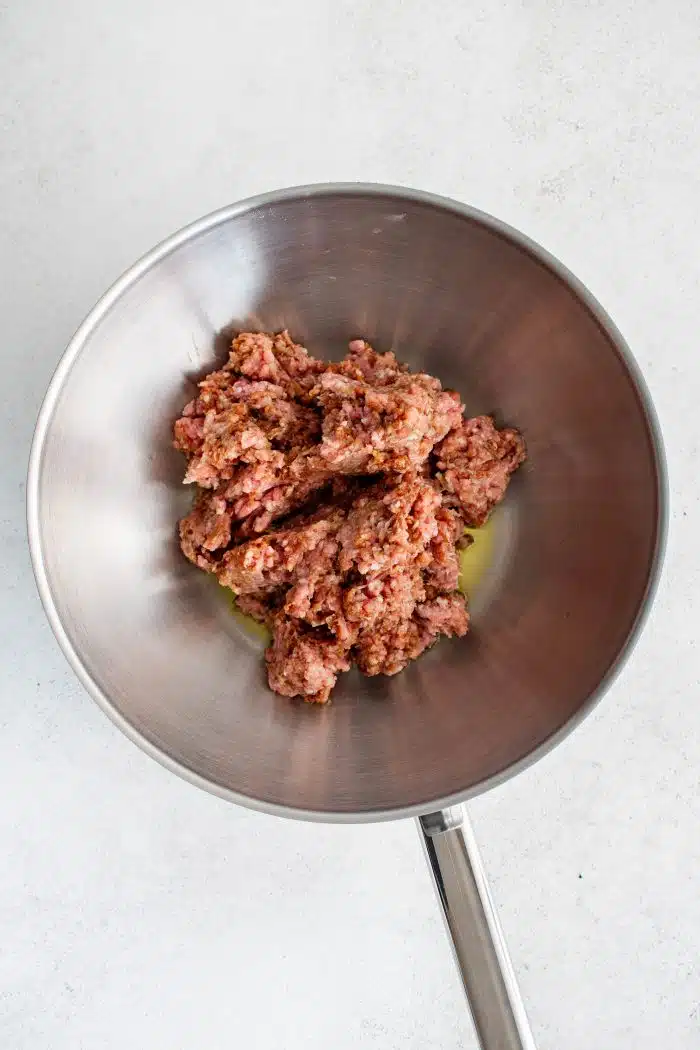Spicy, savory, nutty, and tangy, Dan Dan Noodles are famous for their complex layering of flavors and sensations. Bursting with authentic Sichuan flavor, discover how to make spicy Sichuan noodles with ground pork in your very own kitchen!

Dan dan noodles are a fabulous layering of complex flavors. It’s a dish that’s worth the extra effort, especially for anyone who loves a big bowl of slurpable, spicy noodles.
What are Dan Dan Noodles?
Dan dan noodles (担担面, dan dan mian) is a traditional noodle dish originating from Chinese Sichuan cuisine. The dish consists of noodles tossed in a spicy sauce made with Sichuan peppercorns and chili oil, with preserved vegetables (often pickled mustard stems or Zha Cai) and minced pork. One of the most popular street foods, the dish gets its name from the type of carrying pole (dan dan) that is used by walking street vendors who sell the dish.
The sauce can vary in spiciness, depending on the amount of chili oil and Sichuan pepper added to the sauce. Sichuan peppercorns also add a unique tingling sensation to the tongue – similar to what you experience with the dishes Sichuan chicken and kung pao chicken.
Originally, dan dan noodles were served without any added soup or broth, but a soup variant from Hong Kong has become a popular option throughout the rest of China (minus Sichuan).
This recipe adds a small amount of broth to loosen the sauce, but not so much that it resembles a soup.

How to Make Dan Dan Noodles
1. Season the ground pork: In a large bowl, combine the pork with the minced garlic, Chinese cooking wine, soy sauce, mirin, oil, ginger, and Chinese five spice. Mix well, then set aside to marinate for 15 minutes.

2. Prepare the Sichuan Peppercorns: In a dry pan over medium-low to medium heat, toast the Sichuan peppercorns until fragrant, about 5 minutes, stirring constantly. Grind the peppercorns using a mortar and pestle or a spice grinder until ground, then add 2-3 teaspoons to a medium bowl. (Add more if you prefer a spicier, tinglier sauce)



3. Make the sauce: Add the chili oil, sesame paste, soy sauce, garlic, sugar, and sesame oil to the medium bowl containing 2-3 teaspoons of ground Szechuan peppercorns. Whisk well until it forms a paste, then set aside.


4. Cook the noodles: Bring a large pot of salted water to a boil. Cook the noodles according to package directions or until al dente. If you’re cooking semi-fresh wheat noodles, they cook quickly! 1-2 minutes at most. In this case, add the baby bok choy at the same time. If using dry noodles, add the baby bok choy (or other green veggies) in the last two minutes of cooking. Remove the greens to an ice bath to stop cooking and drain the noodles.

5. Brown the pork: Heat a large skillet or wok over medium heat and coat the bottom with oil. Add the prepared pork, and cook, breaking it up with a spatula, until browned and cooked through, about 6-8 minutes. Add the preserved mustard greens and cook for an additional 5 minutes.


6. Assemble: In a shallow serving bowl, add half of the spicy sauce, cooked noodles, cooked pork, 1-2 bok choy, and 2-3 tablespoons of chicken broth. Repeat for the second serving.
7. Garnish: Sprinkle with chopped green onions/scallions and crushed peanuts, if desired.



Frequently Asked Questions
Dan dan noodles are traditionally made with round, thin to medium-thin Chinese wheat noodles – not rice noodles. Most Asian markets will carry semi-fresh wheat noodles in the refrigerated section; however, they won’t be labeled as “dan dan noodles,” so be sure to check the ingredients. If an Asian grocery store isn’t nearby, dry, round, thin Asian-style wheat noodles will also work. In a pinch, you can try using noodles like spaghetti or linguine, but the texture and taste will be slightly different from the traditional dish.
Sichuan Peppercorns have a somewhat tingling or numbing effect rather than a burning hot effect on the mouth. Pre-toasted and ground peppercorns are the best option; otherwise, you’ll want to toast them in a dry pan over medium-low heat just until fragrant and then grind them. You can find them at Asian grocery stores and supermarkets, Whole Foods, or online.
Sui Mi Ya Cai (碎米芽菜) is a type of preserved mustard green from Sichuan, China. After a process of fermentation, the result is a sweet, tangy, and slightly salty flavor unique to Sui Mi Ya Cai. This unique flavor makes it an essential ingredient to dan dan noodles and is hard to reproduce using other ingredients. You can find Sui Mi Ya Cai is usually sold in vacuum-sealed packets in Chinese or Asian grocery stores.

How to Store Leftover Dan Dan Noodles
Storing: If possible, try to store the noodles separately from the remaining ingredients to keep them from getting too soggy. Allow the noodles and sauce to cool to room temperature before transferring them to airtight containers. Transfer to the refrigerator for up to 3-5 days.
Freezing: The sauce will freeze well for up to 2-3 months, but it is not recommended to free the noodles as they will turn mushy when thawed and reheated.
More Noodle Stir-Fry Recipes
- Lo Mein Recipe
- Pad Woon Sen
- Yaki Udon (Stir Fried Udon Noodles)
- Yakisoba Noodles Recipe
- Asian Garlic Noodles
- Pad See Ew Recipe (Thai Noodles Cooked with Soy Sauce)
If you try making this Dan Dan Noodle Recipe, please leave me a comment and let me know! I always love to hear your thoughts.

RECIPE CARD

Dan Dan Noodles Recipe
Ingredients
- 1 pound ground pork
- 3 cloves garlic - roughly chopped
- 2 tablespoon Shaoxing Wine - (Chinese cooking wine)
- 1 tablespoon soy sauce
- 1 tablespoon marin
- 1 tablespoon vegetable oil - or peanut oil
- 1 teaspoon fresh ginger - chopped
- ½ teaspoon Chinese five spice
- 8 ounces fresh Chinese wheat noodles - or spaghetti noodles, cooked until al dente
- 4 baby bok choy
- ¾ cup Sui Mi Ya Cai (Chinese Preserved Mustard Greens) - chopped, or 1 1/2 cups of baby spinach
- ½ cup chicken broth - heated until boiling
- Chopped green onions and peanuts - to garnish
Sauce Ingredients
- ¼ cup whole Sichuan peppercorns
- 2-3 tablespoon crispy chili oil
- 2 tablespoon Chinese sesame paste - or tahini or unsweetened peanut butter
- 2 tablespoon soy sauce
- 2 cloves garlic - minced
- 1 teaspoon granulated sugar
- 1 teaspoon sesame oil
Instructions
- In a large bowl, combine the pork, garlic, Chinese cooking wine, soy sauce, mirin, vegetable oil, ginger, and Chinese five spice. Mix well, then set aside to marinate for 15 minutes.
- Toast the Sichuan peppercorns in a small pan over medium heat until fragrant, about 5 minutes, stirring constantly.
- Grind the peppercorns with a mortar and pestle or a spice grinder until fine, then add 2-3 teaspoons to a medium bowl. (Add more if you prefer a spicier, tinglier sauce)
- Add the chili oil, sesame paste, soy sauce, garlic, sugar, and sesame oil, to the medium bowl and whisk well to form a paste. Set aside.
- If using spaghetti pasta, bring a large pot of salted water to a boil and cook the noodles according to the package instructions until al dente. If using fresh noodles, cook for 2 minutes and drain immediately. Do not overcook.
- Add the bok choy to the pasta water and blanch for 1 minute. Remove to an ice bath to stop cooking. Drain the noodles and set aside.
- Heat a large skillet or wok over medium heat and coat the bottom with oil. Add the prepared meat, and cook, breaking it up with a spatula, until browned and cooked through, about 6-8 minutes.
- Stir in the mustard greens and cook for 5 minutes.
- To serve, take a serving bowl and add half of the spicy sauce, cooked noodles, cooked pork, 1-2 bok choy, and 2-3 tablespoons of chicken broth. Repeat for the second serving.
- Garnish with chopped green onions and crushed peanuts if desired.
Jessica’s Notes
- For the most authentic smokey flavor, try to buy toasted sesame seed paste or Chinese sesame seed paste. Tahini works as well, but it won’t have the same flavor since the sesame seeds haven’t been toasted.
Nutritional Information
(Nutrition information provided is an estimate and will vary based on cooking methods and specific brands of ingredients used.)




Last Updated | 0 Comments